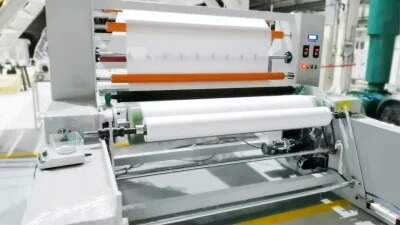重置帐户密码
对于帐户
6-20 个字符(仅限字母加数字)
密码不一致
重置成功
您的密码已重置。您可以使用新密码登录。
登录


What is the Difference Between Spunbonding and Meltblown?
2025-01-14 10:09:58
Today, we're diving into the nitty-gritty of two super important nonwoven production methods - spunbonding and meltblown. If you're in the game of manufacturing materials for anything from hygiene products to filtration systems, you've likely come across these terms. So, let's break it down and make it as clear as day, shall we?
Spunbonding Process
A Quick Lowdown
Spunbonding, my friends, is like the workhorse of the nonwoven world. It's all about taking polymer and turning it into continuous filaments that form a nice, strong web. Think of it as building a sturdy bridge - you need those solid, continuous beams (filaments) to hold everything together. This process is super popular for making stuff like geotextiles that reinforce soil, or the outer layers of those fancy diapers that keep our little ones dry.
The Nuts and Bolts
-
Polymer Melting: So, you start with these polymer pellets. Imagine them as little Lego bricks that you're about to melt down. You heat them up until they're all gooey and ready to be shaped. This is like prepping your ingredients before you start cooking - crucial for the next steps.
-
Extrusion: Now, you push this molten polymer through spinnerets. These are like tiny nozzles that squeeze out the polymer into continuous filaments. It's similar to using a piping bag to decorate a cake - you control the flow and shape of the frosting (polymer) as it comes out.
-
Drawing: Once the filaments are out, they need a bit of a stretch to get them aligned and give them the right properties. It's like taking a piece of taffy and pulling it to make it longer and thinner. This step helps the filaments become more uniform and strong.
-
Laying: The filaments are then laid down on a moving conveyor. Picture a bunch of threads being gently placed on a moving belt, forming a nice, even layer. This layer is the start of your nonwoven fabric.
-
Bonding: Finally, you need to bond these filaments together so they don't just fall apart. You can use heat (thermal bonding) or chemicals to make them stick together. It's like using glue or heat to attach pieces of a puzzle, making sure they stay in place.
Meltblown Process
The Basics
Meltblown, on the other hand, is like the delicate artist of the nonwoven family. It's all about creating these ultrafine fibers that are perfect for applications where you need high filtration or softness. Think of it as making a fluffy cloud of fibers - light, airy, and super effective at catching tiny particles.
The Detailed Steps
-
Polymer Melting: This is similar to spunbonding, but you need to crank up the heat and pressure a bit more. It's like making a thicker sauce - you need more heat to get it to the right consistency.
-
Extrusion and Attenuation: Here's where it gets interesting. The polymer is extruded through a die with many tiny holes, and as soon as it comes out, it gets hit with hot air. This hot air is like a mini tornado that stretches the polymer into ultrafine fibers. It's a bit like blowing cotton candy - the sugar solution comes out and the air stretches it into those delicate strands.
-
Fiber Collection: The fibers are collected on a moving screen. It's like catching snowflakes on a piece of paper - the fibers are so light and fluffy, they just gently settle down to form a web.
-
Web Formation and Bonding: In meltblown, the web formation is a bit more delicate. The fibers are so fine that they can be influenced by static electricity, which helps them stick together. It's like when you rub a balloon on your hair and it sticks to the wall - the static helps the fibers bond without needing too much heat or chemicals.
Key Differences
Fiber Characteristics
-
Diameter: Spunbonding gives you relatively thicker fibers, like the threads in a piece of canvas. Meltblown, though, creates these super-duper fine fibers, almost like a spider's web. This difference in diameter leads to different properties. Spunbonded materials are generally stronger and more durable, while meltblown materials are lighter and have better filtration capabilities. For example, a spunbonded geotextile can handle heavy loads in construction, but a meltblown filter can catch tiny particles in the air.
-
Properties: Because of the fiber size, spunbonded materials are great for when you need something that can take a beating. They're like the tough guys in the material world. Meltblown materials, with their fine fibers, are the sensitive souls - great at capturing small particles and providing a soft touch. Think of a meltblown mask - it can filter out tiny virus particles, something a spunbonded material might not be as effective at.
Production Speed and Efficiency
-
Speed: Spunbonding is like a sprinter - it's fast! The continuous filaments can be laid down quickly, making it a go-to process for high-volume production. Meltblown, however, is more like a marathon runner. The process of attenuating the fibers with hot air and collecting them gently takes more time. It's a bit more finicky, but the results are worth it for certain applications.
-
Efficiency: In terms of energy, spunbonding is generally more efficient. It doesn't require as much heat and pressure as meltblown. The equipment for spunbonding is also a bit simpler, which means less maintenance and lower operating costs. But hey, sometimes you're willing to pay a bit more for the unique properties that meltblown can offer.
Applications
-
Spunbonded Materials: These are the workhorses of the nonwoven world. They're used in geotextiles to reinforce soil and prevent erosion. In the hygiene industry, they form the outer layers of diapers and sanitary pads, providing strength and protection. They're like the sturdy outer shell of a product, keeping everything together.
-
Meltblown Materials: Now, these are the stars of the show when it comes to filtration and softness. Meltblown filters are used in air and liquid filtration systems because their fine fibers can catch tiny particles. During the COVID-19 pandemic, meltblown materials really shined as they were used in the inner layers of masks to filter out virus particles. They're also used in medical gowns and drapes for their softness and barrier properties.
Choosing the Right Process
So, how do you decide between spunbonding and meltblown? Well, it's like choosing between a hammer and a screwdriver - it depends on the job you need to do. If you're looking for a strong, durable material that can handle heavy loads or be the outer layer of a product, spunbonding is your buddy. But if you need something that can filter out tiny particles or provide a soft, comfortable feel, meltblown is the way to go.
Consider the end-use requirements of your product. Are you making a product that needs to last a long time and withstand rough conditions? Spunbonding might be the better choice. Or are you creating a filtration system that needs to catch microscopic particles? Meltblown will be your hero. And of course, cost comes into play. Spunbonding is generally more cost-effective for large-scale production, while meltblown might be a bit pricier due to its slower production speed and higher energy requirements.
Conclusion
There you have it, folks! Spunbonding and meltblown - two awesome nonwoven production methods with their own unique characteristics and applications. Remember, it's all about knowing what you need for your specific project. Whether you're building a sturdy bridge with spunbonded materials or creating a soft, filtering cloud with meltblown, both processes have their place in our industry.
When you're trying to decide which process to use, just remember our conversation. If you have any questions or need advice, feel free to ask. We're all in this industry together and we're here to support each other.
联系我们

